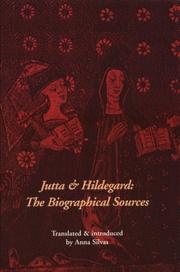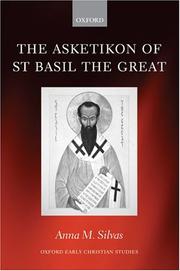| Listing 1 - 8 of 8 |
Sort by
|

ISBN: 0271019549 Year: 1999 Publisher: University Park, Pa. : Pennsylvania State University Press,
Abstract | Keywords | Export | Availability | Bookmark
 Loading...
Loading...Choose an application
- Reference Manager
- EndNote
- RefWorks (Direct export to RefWorks)
Christian saints --- Saints chrétiens --- Biography --- Biographie --- Hildegard, --- Jutta, --- Hermits --- 248 HILDEGARDIS BINGENSIS --- 248 JUTTA --- Anchorites --- Eremites --- Persons --- Hermitages --- Recluses --- Saints --- Canonization --- Spiritualiteit. Ascese. Mystiek. Vroomheid--HILDEGARDIS BINGENSIS --- Spiritualiteit. Ascese. Mystiek. Vroomheid--JUTTA --- Bingen, Hildegard von, --- Hildegarde, --- Hildegardis, --- Ildegarda, --- Hildegardis Bingensis --- Hildegard von Bingen --- Hildegard van Bingen --- Hildegarde de Bingen --- Hildegard of Bingen --- von Bingen, Hildegard
Book
Year: 1999 Publisher: Turnhout Brepols
Abstract | Keywords | Export | Availability | Bookmark
 Loading...
Loading...Choose an application
- Reference Manager
- EndNote
- RefWorks (Direct export to RefWorks)
Christian saints --- -Hermits --- -Biography --- Biography --- Hildegard Saint --- Jutta of Disibodenberg --- Hildegard von Bingen
Book
ISBN: 9789004252271 9004252274 9789004266810 900426681X 9789004266810 Year: 2014 Volume: 3 Publisher: Brill
Abstract | Keywords | Export | Availability | Bookmark
 Loading...
Loading...Choose an application
- Reference Manager
- EndNote
- RefWorks (Direct export to RefWorks)
Basil of Caesarea (c. 328-378) was the great father of Christian monasticism in eastern Anatolia, whose influence spread into all the Greek, Latin and Syriac speaking churches. Basil’s counsels for ascetics in community are collected in his Asketikon . The earliest version, the Small Asketikon , did not survive in the Greek, but only in a Latin translation ( The Rule of Basil ), and in a Syriac translation ( The Questions of the Brothers ). Silvas presents the first ever edition of the entire Syriac translation, drawn from five manuscripts, the oldest from the late 5th century. The introductory study shows how the Syriac translator was himself a warm-hearted spiritual father who made his own authorial contributions to the Questions of the Brothers .
Monasticism and religious orders --- Basil, --- Monachism --- Monastic orders --- Monasticism and religious orders for men --- Monasticism and religious orders of men --- Orders, Monastic --- Orders, Religious --- Religious orders --- Brotherhoods --- Christian communities --- Brothers (Religious) --- Friars --- Monks --- Superiors, Religious --- Basil, Saint, --- Monasticism and religious orders - Early works to 1800 --- Basil, - Saint, Bishop of Caesarea, - approximately 329-379. - Small asketikon
Book
ISBN: 2503507794 9782503507798 Year: 1998 Volume: 1 Publisher: Turnhout : Brepols,
Abstract | Keywords | Export | Availability | Bookmark
 Loading...
Loading...Choose an application
- Reference Manager
- EndNote
- RefWorks (Direct export to RefWorks)
Jutta of Disibodenberg --- Hildegard of Bingen --- FEMMES --- HILDEGARDE DE BINGEN (SAINTE), MYSTIQUE ET BENEDICTINE, 1098-1179 --- ALLEMAGNE --- VIE INTELLECTUELLE --- MOYEN AGE --- CRITIQUE ET INTERPRETATION --- BIOGRAPHIE

ISSN: 0920623X ISBN: 9004152903 9789004152908 9786611399931 1281399930 904741053X 9789047410539 9781281399939 6611399933 Year: 2007 Volume: 83 Publisher: Leiden ; Boston : Brill,
Abstract | Keywords | Export | Availability | Bookmark
 Loading...
Loading...Choose an application
- Reference Manager
- EndNote
- RefWorks (Direct export to RefWorks)
This book gathers 37 letters of St Gregory of Nyssa (c. 335-394), translated into English, some for the first time, and equipped with up-to-date scholarly notes. It begins with a biography focusing on Gregory’s family background and young adulthood. A study of Gregory the letter writer follows, with a dateline of the letters. Three sub-collections of letters follow: 1. ‘Prelude’ comprising testimonia from Basil and Gregory Nazianzen, 2. ‘The Pasquali Collection’, the 30 letters established by G. Pasquali, 3. ‘Supplementary’, one letter always known as Gregory’s, five letters reassigned to Gregory by scholars, and a new one proposed by the author for reassignment. A specially commissioned icon, an original map, and two architectural sketches are included. This book will both stimulate veteran scholars in the Cappadocian Fathers and early Christianity, and serve English speaking lovers of the Fathers who do not have ready access to the sources in other languages.
Christian saints --- Gregory, --- -276 =75 GREGORIUS NAZIANZENUS --- Saints --- Canonization --- Correspondence. --- Griekse patrologie--GREGORIUS NAZIANZENUS --- 276 =75 GREGORIUS NAZIANZENUS --- Ghirīghūriyūs, --- Grégoire, --- Gregor, --- Gregori, --- Gregorio, --- Grēgorios, --- Gregorius, --- Grigoli, --- Grigoriĭ, --- Grzegorz, --- Qiddīs Ghirīghūriyūs Usquf Nīṣṣ, --- Grigorije, --- Gregorius Nyssenus --- Gregor von Nyssa --- Gregorio di Nissa --- Gregorius van Nyssa --- Gregory of Nyssa --- Grégoire de Nysse --- Christian saints - Turkey - Correspondence --- Gregory, - of Nyssa, Saint, - ca. 335-ca. 394 - Correspondence --- Gregory, - of Nyssa, Saint, - ca. 335-ca. 394
Book
ISBN: 9780814682128 9780814682371 Year: 2013 Publisher: Collegeville Liturgical Press
Abstract | Keywords | Export | Availability | Bookmark
 Loading...
Loading...Choose an application
- Reference Manager
- EndNote
- RefWorks (Direct export to RefWorks)
Basil of Caesarea (AD 329-78), called "the Great" by later generations, was one of the fourth century's greatest theologians and pastors. His influence on the foundation of monastic life was enormous.As he toured the early ascetic communities, members would ask Basil about various aspects of living the Gospel life. Their questions and Basil's replies were taken down by tachygraphers and eventually became the Small Asketikon, first published in 366. The Regula Basilii is a Latin translation of this work, done by Rufinus of Aquileia in 397. It is one of the major sources of the Rule of Saint Benedict, and Benedict recommends it to zealous monks, calling it "the rule of our holy father Basil."This volume represents a new Latin edition, translated and annotated in English by Anna M. Silvas. It is based on the Latin text Basili Regula—A Rufino Latine Versa from Klaus Zelzer: Corpus Scriptorum Ecclesiastricoum Latinorum, Vol. 86. It also includes three extra questions and answers that survive only in the Syriac translation. Silvas balances masterfully between the rigors of academic research and the interests of an intelligent, non-specialist readership. This volume promises to become an indispensable resource in understanding both the history and the spirituality of monastic life.
Orthodox Eastern monasticism and religious orders --- Rules --- Basil,

ISBN: 0199273510 9780199273515 Year: 2005 Volume: *17 Publisher: Oxford [etc.] Oxford University Press
Abstract | Keywords | Export | Availability | Bookmark
 Loading...
Loading...Choose an application
- Reference Manager
- EndNote
- RefWorks (Direct export to RefWorks)
The Asketikon of St Basil the Great comprises a new English translation and studies which re-examine the emergence of monasticism in Asia Minor. The Regula Basilii, translated by Rufinus from Basil's Small Asketikon, is closely compared with the Greek text of the longer edition, as a means to tracing the development of ideas. Silvas concludes that the antecedents of the monastic community of the Great Asketikon are best sought not in some kind of sub-orthodox modus vivendi of male and female ascetics living together and increasingly curbed by an emerging neo-Nicene orthodoxy less favourable to women ('homoiousian asceticism'), but in the local domestic ascetic movement in Anatolia as typified in the developments at Annisa under the leadership of Makrina.
276 =75 BASILIUS MAGNUS --- Griekse patrologie--BASILIUS MAGNUS --- Theology --- History --- Basil, --- Criticism and interpretation. --- Barsegh, --- Basile, --- Basileios, --- Basili, --- Basilio, --- Basilius Caesariensis, --- Basilius Cesariensis, --- Basilius, --- Bāsīliyūs, --- Bazyli, --- Magnus Basilius, --- Qiddīs Bāsīliyūs al-Kabīr, --- Vasile, --- Vasileios, --- Vasiliĭ, --- Vasilije, --- Vasyliĭ, --- Pseudo-Basil
Book
ISBN: 9782503523903 2503523900 Year: 2008 Volume: 22 Publisher: Turnhout: Brepols,
Abstract | Keywords | Export | Availability | Bookmark
 Loading...
Loading...Choose an application
- Reference Manager
- EndNote
- RefWorks (Direct export to RefWorks)
Christian women saints --- Christian saints --- Macrina, --- 276 =75 BASILIUS MAGNUS --- Griekse patrologie--BASILIUS MAGNUS --- Macrina, the Younger --- Sources --- Biography --- Saints --- Canonization --- Christian women saints - Biography --- Christian saints - Biography - Sources --- Macrina soror S. Basilii et Gregorii Nysseni --- Macrina, - the Younger, Saint, - ca. 330-379 or 380 --- Macrina, - the Younger, Saint, - ca. 330-379 or 380 - Sources
| Listing 1 - 8 of 8 |
Sort by
|

 Search
Search Feedback
Feedback About UniCat
About UniCat  Help
Help News
News